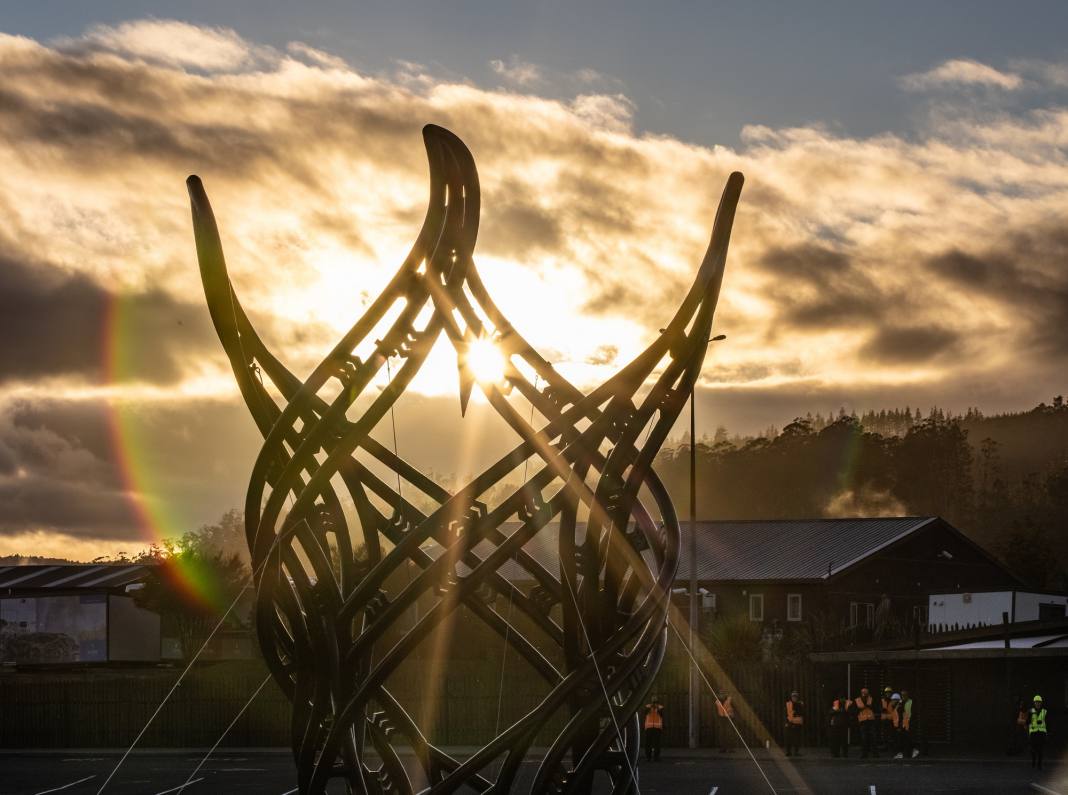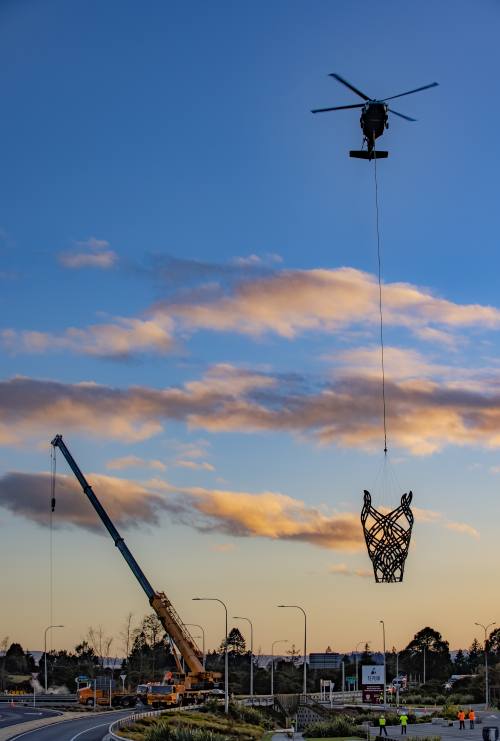Partners, funders and contributors marked the successful completion of the striking Te Ahi Tupua at the end of January with a karakia at the sculpture, which is the centrepiece for upgrades to the intersection of State Highway 5 and 30, the roundabout at the southern entrance to Rotorua.
It was an opportunity for partners and contributors to come together to acknowledge and recognise those who had a hand in telling a significant Te Arawa story.
They spoke to the complex journey, the significance of the design and location, and the importance of storytelling to our people and place.
Te Puia CEO, Tim Cossar, said it was pleasing to see Te Ahi Tupua complete and in place to showcase the rich Māori heritage, identity, and values of Rotorua.
“Whilst it was a complicated project, with many ‘firstever’ initiatives, we are very proud of the concept, which speaks to a significant Te Arawa narrative and represents the arrival of geothermal to our district.
“The innovation in the way it was designed and constructed provides a perfect example of the talented people we have within our rohe.”
Designed by Te Puia │ NZMACI, the sculpture is seen as a unique way to tell the stories of the region, including the origins of the geothermal features and the story of Te Arawa tohunga (high priest) Ngātoro-i-rangi, who was responsible for the safe passage of his people to Aotearoa.
“The sculpture also provides another opportunity for NZMACI to fulfil its Government mandate, to perpetuate, preserve and promote Māori arts and crafts – but in a contemporary way, with the design derived from whakairo rākau (wood carving),” said Cossar.”
Kilwell Fibretube Chief Executive Craig Wilson said the creation of this significant piece of art for Rotorua is the result of collaboration across many organisations and with many individuals.
Photos – Stephen Parker.
Partners were able to acknowledge the innovation and perseverance of local composite engineering firm Kilwell Fibretube. The family-owned business has operated in Rotorua for more than 50 years with its sports division operating for more than 80.
“We are immensely proud of our staff for the thousands of hours of work during the two year construction period and today was an opportunity to acknowledge that work and the work of the many others that contributed to Te Ahi Tupua. From the start this project aligned with our businesses principles of continuous learning and giving back to the community.
“We also want to acknowledge Stacy and the team from Te Puia │ NZMACI. They were willing to try a new medium and explore the possibilities of blending traditional practices with a different type of modern technology. This brought with it challenges but our crew were able to meet those challenges with innovative solutions which is one of the most important parts of our business.”
Wilson told Bay of Plenty Business News there were a number of issues in becoming involved in the project.
‘Lakes Council at the time was having trouble raising funds and we were at the time approaching a whole lot of stuff for an American firm and thought that printing would be a good option because of the curvature and the design of the sculpture,” said Wilson.
“It is line with our principles of trying new things and putting back into the community so it ticked a lot of boxes.”
Although Kilwell has been operational in Rotorua for many years, some 90 percent of what it produces goes offshore, so Wilson said it was also a good opportunity to demonstrate that “Kilwell doesn’t just make fishing rods”, he said.
“We do make a few, but it’s only one or two percent of our business,” said Wilson.
“Now we produce everything from aerospace to airships, plus we’re doing a lot for the America’s Cup,” he said.
The journey began in 2015 when Rotorua Lakes Council and Waka Kotahi NZ Transport Agency agreed to enter into a partnership to commission a large-scale artwork to become the roundabout centrepiece.
In the last month, the three remaining manaia, lighting and decorative base cover were installed. In late January, Dr Ken Kennedy and Rawiri Waru blessed the finished sculpture with a karakia to embed the mauri (life force) into Te Ahi Tupua after its journey from conception through to installation.








